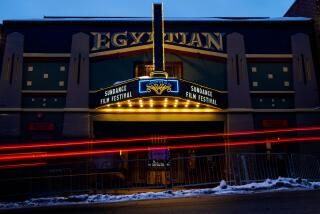A movable festival
Sundance Film Festival founder Robert Redford says many outstanding independent films screen at Sundance each year that receive only extremely limited distribution -- or none at all -- because they are not easily marketable.
âThere are films out there that are absolutely worth seeing,â he says.
To help some of those films reach a wider audience, as well as to take a slice of the Sundance experience to those outside Park City, Utah, the inaugural Sundance Film Series is bringing a slate of four films to 10 major cities, beginning Friday with âThe Other Side of the Bed,â a musical bedroom farce from Spain. Each film will play for two weeks at a Loews Cineplex theater in each city, longer if audiences are large enough. In addition to Los Angeles and New York, the cities are San Francisco, Chicago, Washington, D.C., Boston, Baltimore, Dallas, Detroit and Seattle.
âWeâre taking films that were either missed in the marketplace or bypassed for whatever reasons ...,â Redford says. âWeâre simply saying, âLet the audiences have a chance to see this is whatâs out there.â â
The other films in the series are âIn This Worldâ (opening Sept. 19), Michael Winterbottomâs documentary-style account of two Afghan refugees; âDopamineâ (Oct. 10), a philosophical romance from first-time writer-director Mark Decena; and âDie Mommie Die!â (Oct. 31), an affectionate sendup of classic Hollywood melodramas, based on a play by Charles Busch.
After their theatrical runs, the films will be released on video and DVD through Sundance Channel Home Entertainment and will later play on Sundance Channel.
The series recalls the Shooting Gallery Film Series of a few years ago that notably nurtured âCroupierâ into a breakout independent hit that grossed $6.2 million. But Redford says the Sundance Film Series is more an outgrowth of the festival and the aborted plan for a chain of Sundance Cinemas, which was announced in 1997 but fell apart when partner General Cinemas filed for bankruptcy in 2000. With the exhibition business in turmoil, other investors were scarce.
Sundance Channel, which put together the series, recruited four corporate sponsors -- Coca-Cola, Entertainment Weekly, Kenneth Cole and Volkswagen -- who will cover marketing costs for the films. Paula Freccero, senior vice president of film programming for Sundance Channel, estimates that, along with the promotional efforts of Loews, it will be the equivalent of a $3-million to $5-million advertising campaign for each film, much larger than these films would usually be given by a boutique distributor.
To encourage moviegoers to regard the four films as a series, Loews is selling â4-Packâ series passes at a 30% discount off the regular admission price that will be valid at any showing during the two-week run of each film, subject to seating availability.
Seriesâ site in L.A. area
In Los Angeles, the series will play at the Loews Cineplex Beverly Center, where the films will play in one of the multiplexâs two larger theaters at least for the first week. The filmmakers will travel to as many cities playing the series as they can, and instead of the usual 15 minutes of advertising and trailers for upcoming films, there will be a five-minute pre-show of commercials from the Sundance Film Series sponsors and a taped introduction by the filmmakers in which they elaborate on their films much as they would at a festival.
âThe mantra from Robert Redford has been, âWherever possible, letâs try to replicate the festival experience,â â says Larry Aidem, president and CEO of Sundance Channel. To further distinguish the series in multiplexes, theater managers will personally introduce the films, Kenneth Cole will outfit some of the theater staff and a separate waiting area will be set up for those holding series tickets.
If any of the films click during their two-week run, Sundance Channel and Loews will offer additional advertising support and extend the run in the initial 10 cities or expand into more, even into theaters other than Loews.
âWeâre going to be very flexible,â says Loews Cineplex Theatres president and CEO Travis Reid, who also notes that Loews is offering a âfilmmaker-friendlyâ distributor-exhibitor split on the box office with Sundance. Freccero says any profits in the first two weeks will be split between the filmmakers and the not-for-profit Sundance Institute; the sponsors and the for-profit Sundance Channel will not collect any money.
Where normally a distributor would deduct advertising costs before turning over profits, here âthe filmmakers are going to make money off of the box office essentially from dollar one,â Freccero says. In programming the series, Sundance Channel wanted to represent the diversity of what is screened at the festival. âThere was nothing really that was off-limits -- foreign-language, documentary, feature,â Freccero says.
Nor were the offerings to be limited to films that played at Sundance. âItâs meant to be the spirit of Sundance as much as it is meant to be literally coming out of Sundance,â she says. âThe Other Side of the Bedâ was scouted last year at Toronto and âIn this Worldâ at Berlin this year, where it won the top prize, the Golden Bear. At this yearâs Sundance, their goal was not to compete for the higher-profile film with the larger players like Miramax and Fox Searchlight, âbut to try and give a platform to films that we really thought were good and were solid and were deserving of an audience but that werenât the flashiest kids on the block,â Freccero says.
However, unlike Shooting Gallery, which mainly acquired films on which other distributors had passed, the Sundance Film Series was competing with micro-distributors who might guarantee a release only in New York and Los Angeles. âDopamineâ and âDie Mommie Die!â both had other suitors at Sundance, but the filmmakers chose to go with the Sundance series.
âTo me, for a little film like ours, to have the support of this organization and the sponsors was the best possible thing that could happen for us,â says âDie Mommie Die!â director Mark Rucker. âOther distributors didnât have the ability to get the word out about the film as much as what this looks like it will do.â For âDie Mommie Die!,â a comedy in which playwright Busch (âThe Tale of the Allergistâs Wifeâ) plays the female lead character in drag, the Sundance Film Series offered a distribution pattern outside of the traditional gay art-house circuit.
Thorough support
âDopamine,â which intertwines an unfolding romance between a computer programmer and a kindergarten teacher with ruminations on the nature of love, stands as the first film to have Sundance support at every stage, from being developed at the writing and directing labs at the Institute to premiering at the festival and now being distributed by Sundance theatrically and later on home video and the channel. âItâs the one film in the mix that represents the total through-line from beginning to end for our commitment,â Redford says.
Although critical reaction to âDopamineâ was mixed at the festival, Freccero says word-of-mouth among audiences was strong. âOne of the things we knew we were looking for was the quintessential American indie, the kind of film that you know was put together on passion and gumption that was well-written,â she says.
Director Decena says that without the involvement of Sundance he might not have ever made the film: âThey were an inspiration for me to keep going.â Originally, Sundance Channel thought it would book the film series at independent art houses in each city rather than partner with a big theater chain like Loews, which had hosted the Shooting Gallery series for its three seasons in 2000 and 2001.
âWe went over there skeptically,â Freccero says. (The Shooting Gallery company went belly-up in 2001.) The Shooting Gallery series âwasnât in the greatest of theaters, and we didnât really feel like they supported it all that well.â But Loews eagerly offered its best theaters in the biggest cities and a sizable amount of in-theater promotion.
Redford would like to continue the Sundance Film Series next fall and hopes eventually to revive plans for Sundance Cinemas. âWeâre in an experimental stage right now,â says Redford, who sees a hunger for independent film from the audiences that come from across the country each year to the Sundance Film Festival. For the series, he says, âwe put together a menu thatâs as diverse as possible, saying, âLook, this is whatâs out there in terms of independent film.â... But finally the test is going to come with the audience.â
More to Read
The biggest entertainment stories
Get our big stories about Hollywood, film, television, music, arts, culture and more right in your inbox as soon as they publish.
You may occasionally receive promotional content from the Los Angeles Times.










